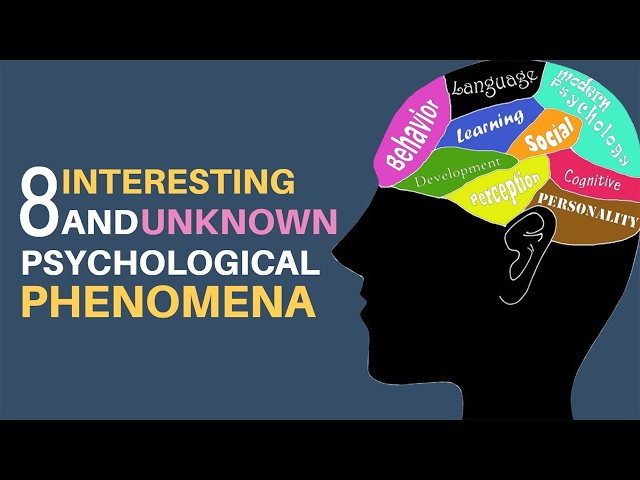Have you ever wondered about the mysterious workings of the human mind? In this article, we will delve into the fascinating world of lesser-known psychological phenomena that will leave you in awe. Understanding these hidden aspects of our psyche can offer profound insights into human behavior and cognition. Get ready to be intrigued and captivated as we explore eight mind-boggling psychological phenomena that you’ve likely never heard of before.
Number One: The Baader-Meinhof Phenomenon
The Baader-Meinhof phenomenon, also known as the frequency illusion, occurs when you learn about something new and suddenly start noticing it everywhere. This phenomenon is rooted in selective attention and cognitive bias, where our brains prioritize information that is already familiar to us. For instance, you may start seeing the same model of car on the road more frequently after buying a new car. This phenomenon highlights how our existing knowledge and experiences influence our perception. It also raises questions about the reliability of our memory and the impact of cognitive biases on our daily interactions and decision-making processes.
Number Two: The Dunning-Kruger Effect
A cognitive bias known as the Dunning-Kruger effect causes people with low ability at a task to overestimate their skill level. This phenomenon can lead to a lack of self-awareness and an inflated sense of skill, potentially hindering personal growth and development. The root of this bias lies in a lack of metacognitive skills, preventing individuals from accurately assessing their performance. To combat the negative effects of the Dunning-Kruger effect, it is crucial to encourage self-reflection, seek feedback from others, and engage in continuous learning and improvement. By fostering humility and a growth mindset, individuals can mitigate the impact of this cognitive bias on their decision-making and interactions.
Number Three: The Zeigarnik Effect
The Zeigarnik effect is a psychological phenomenon where unfinished tasks are more likely to be remembered compared to completed ones. This effect was first observed by psychologist Bluma Zeigarnik, who noticed that incomplete tasks tend to linger in our minds, creating a sense of mental tension until they are resolved. In daily life, this phenomenon can influence our memory retention and productivity, as unfinished tasks may occupy our thoughts and distract us from other activities. By leveraging the Zeigarnik effect, individuals can enhance memory and learning by strategically leaving tasks partially undone to increase retention and motivation to complete them.
Number Four: The Spotlight Effect
The spotlight effect is a cognitive bias in social psychology where individuals tend to overestimate how much others notice or remember about them. This phenomenon stems from our innate self-centered perspective, leading us to believe that we are constantly under the spotlight of others’ attention. The spotlight effect can heighten feelings of self-consciousness and anxiety in social situations, as individuals may fear being judged or scrutinized by others. To overcome the negative effects of this bias, it is important to practice self-compassion, challenge negative self-perceptions, and remind oneself that others are often more focused on themselves than on us. By shifting the spotlight inward and cultivating self-confidence, individuals can navigate social interactions with greater ease and authenticity.
Number Five: The Illusion of Control
The illusion of control is a cognitive bias where individuals believe they have more influence over outcomes than they actually do. This bias is rooted in the concept of perceived control, where individuals overestimate their ability to affect events through their actions. The illusion of control can impact decision-making processes, leading individuals to take unnecessary risks or persist in unproductive behaviors. Psychological factors such as a desire for autonomy, a need for certainty, and a fear of helplessness contribute to this bias. By recognizing and mitigating the illusion of control, individuals can make more informed decisions and navigate uncertainties with greater clarity and adaptability.
Number Six: The Pygmalion Effect
The Pygmalion effect is a phenomenon where higher expectations lead to an increase in performance, creating a self-fulfilling prophecy. This effect highlights the powerful impact of expectations on individual behavior and outcomes. When others believe in our potential and set high expectations for us, we are more likely to rise to meet those expectations. By harnessing the positive effects of the Pygmalion effect, individuals can cultivate a growth mindset, set ambitious goals, and surround themselves with supportive and encouraging influences. Embracing high expectations can fuel personal growth, motivation, and achievement, ultimately shaping a more fulfilling and successful path forward.
Number Seven: The Benjamin Franklin Effect
The Benjamin Franklin effect is a psychological phenomenon where doing a favor for someone can actually make you like them more. This effect is named after a historical incident involving Benjamin Franklin, who won over a political rival by asking to borrow a rare book from him. The underlying psychological mechanisms driving this phenomenon include reciprocity and cognitive dissonance. When we do a favor for someone, we experience cognitive dissonance if we dislike that person, leading us to justify our actions by convincing ourselves that we must actually like them. This effect highlights the power of small gestures in building rapport and fostering positive relationships.
Number Eight: The Bystander Effect
The social psychology phenomenon known as the bystander effect describes how people are less inclined to assist when others are around because of social influence and the spreading of responsibility. When in a group, individuals may assume that someone else will take action, leading to a diffusion of responsibility where no one feels personally accountable to intervene. Real-life examples and case studies, such as the Kitty Genovese murder, underscore the detrimental impact of the bystander effect on helping behavior. To overcome this phenomenon and promote pro-social behavior, fostering a sense of personal responsibility, increasing awareness of the bystander effect, and encouraging bystander intervention training can empower individuals to take action in times of need.







Leave a Comment